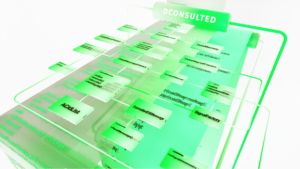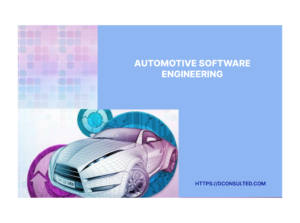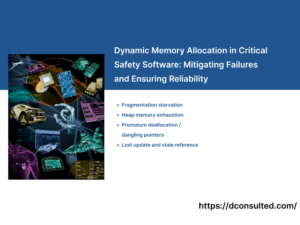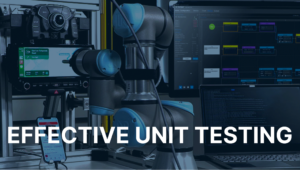
Empowering Your People Isn’t Enough | DConsulted
Learn why empowering employees alone doesn’t guarantee success. Discover how strategic alignment and leadership support drive real results.

Are you still relying on manual methods like Excel in tracing software requirements, entering requirement IDs by hand, and spending days, weeks, or even months conducting ineffective traceability reviews?
Having your team allocate so much of its valuable time to overhead work that could be far better performed by automated requirements traceability systems can overwhelm your team, leading to burnout, frustration, and reduced productivity.
Considering how many companies still trace requirements manually, the significance and advantages of automated traceability might not be widely understood and appreciated. Therefore, this article intends to shed light on the inefficiencies and constraints of manual processes and highlight the time and cost benefits of automated traceability.

The lack of automation in manual tracing presents a major inefficiency, calling for an extensive effort to update, trace, and verify requirements. When specification changes occur, the lack of linking mechanisms means that identifying affected design elements and test cases will require manual parsing, a process that can take hours.
This manual overhead not only increases the risk of errors but also consumes valuable time and resources that could be better applied to actual software development. Automated tracing would autogenerate the necessary traceability information in no time.
Limited collaboration among team members, stakeholders, and across different departments can result in version control issues, delays in communication, and difficulties in tracking changes made by multiple contributors.
Team members are unable to just click through the links in the tool when they pose queries such as “Why is this necessary?” and uncover a requirement’s source. Having to retrieve this information manually adds overhead and is tiring and frustrating work. The backlink traceability in an automated system would highlight that answer immediately.
Difficulty in maintaining consistency between different documents when changes made to requirements in one part of the spreadsheet may not be accurately reflected in other sections. This can lead to discrepancies and potential errors in software development.
Limited scalability as software systems become more complex making management of requirements, dependencies, and relationships unwieldy and error-prone, especially when contending with large volumes of data.
Limited reporting and analysis capabilities needed to gain insights into requirements coverage, test coverage, and project progress can be compromised. Generating meaningful reports and conducting thorough analyses will require additional manual effort and may not be feasible for complex software projects.
Given the prevalence of advanced tools today that can automate the requirements tracing process, the continued reliance on manual tracing with all its limitations is striking, and it may indeed be because of a lack of awareness. Let’s now highlight the benefits of automated requirements traceability, emphasizing its advantages in streamlining workflows, enhancing collaboration, and driving efficiency in software development.
Traceability involves thoroughly tracking a requirement’s lifecycle in both forward and backward directions. This means tracing a requirement from its origin through development, specification, and eventual use, while also accounting for any refinements or changes made along the way.
Additionally, traceability establishes connections between requirements and related elements such as design documents and test cases, ensuring comprehensive coverage throughout the project. In software development, it facilitates tracking requirements across the project lifecycle, while in software testing, it enables the seamless tracing of tests throughout development and backward to their originating requirements. To that end, traceability in software testing is best accomplished using a Traceability Matrix.
In the context of requirements management, a matrix is a structured table used to document and track relationships between various elements such as requirements, design components, test cases, and other project artifacts. This type of matrix is often referred to as a Requirement Traceability Matrix (RTM). An RTM’s main purpose is to track a requirement’s life from its origin through its implementation and testing phases, ensuring that each requirement is traced, operative, and properly validated.
By maintaining a comprehensive RTM throughout the project lifecycle, all stakeholders can be ensured of total transparency. Most importantly, developers can manage changes effectively and reduce the risk of missing requirements. To this extent, an RTM is not just a document but a strategic tool that brings clarity, direction, and quality to software development projects.
The ability to organize requirements is another valuable feature of an RTM. It allows teams to structure project requirements in a hierarchical, nested format, making navigation and management explicit. Requirements are arranged in a logical, tree-like fashion where high-level requirements are broken down into more detailed sub-requirements. This method simplifies navigation and management, enabling team members to trace each requirement back to its roots in the highest-level goals of the software’s design.
A hierarchical matrix also enhances the ability to trace each requirement’s relationship to other project components. This level of clarity is vital, especially when integrating multiple tools, as it helps maintain a well-defined and consistent flow of information across platforms.
In automotive software design and testing, an RTM is essential for ensuring that software systems meet specified requirements and adhere to the ISO 26262 standard. There are many advantages to automated traceability in automotive software design and engineering, including:
Immediate proof of functional safety compliance. An RTM can be used to trace each safety requirement specified in ISO 26262 to the corresponding design components and test cases. This ensures that every requirement is implemented and verified in the software. For example, an RTM can show how a safety requirement related to braking systems is traced to the design components responsible for brake control algorithms and the test cases used to verify their functionality.
Enhancing the tracing of communication protocols between different electronic control units ensures that the logic governing message exchange is well-mapped across the various components of a design. With traceability, a link is established between the requirements for communication and the corresponding tests, leading to dependable communication. For instance, an RTM can illustrate how the necessity to send messages in real time through the CAN bus is directly linked to specific design elements responsible for managing message transmission and handling.
Tracing requirements for each feature in driver assistance systems such as adaptive cruise control or lane-keeping assistance for precise functionality to ensure safe operation. The RTM maps requirements for each driver assistance feature to the corresponding algorithms and modules within the software. It also tracks test cases for scenario-based testing to validate the system’s behavior under various driving conditions. For example, the RTM can illustrate how a requirement for maintaining a safe distance from preceding vehicles in adaptive cruise control is linked to the control algorithms for speed regulation. This is then linked to test cases for evaluating performance in highway traffic scenarios.
Documenting regulatory requirements and their associated software design elements. Automotive software must comply with industry regulations and standards, such as emissions standards or cybersecurity guidelines. The RTM documents regulatory requirements and ensures that each requirement is linked back to the overarching objectives of the software’s design. This this utmost in transparency and helps ensure that the software meets legal and industry-specific compliance criteria.
For example, the matrix can show how requirements related to emissions monitoring and reporting are traced to the software modules responsible for engine control and diagnostic functions, along with test cases for emissions testing and validation.
In each of these examples, an RTM serves as a central tool for managing, tracing, and verifying requirements throughout the automotive software development lifecycle, aiding compliance, reliability, and safety.
While there may be an initial investment required to implement and integrate automated traceability systems, the long-term benefits in terms of time savings, error reduction, improved collaboration, scalability, and compliance can in the long run result in a higher ROI compared to manual tracing with Excel spreadsheets.
When seeking the right requirements traceability system for your organization, ensure your tool has these well-defined attributes:
If your current system lacks these features, consider employing external scripts to automate course file updates. If this doesn’t work evaluate replacing your tool with one better aligned with your requirements. To that end, when assessing potential tools, insist on the following features:
To achieve maximum efficiency, consider a comprehensive tool offering end-to-end capabilities across the entire project lifecycle, encompassing requirements management, design, implementation, testing, and maintenance. Solutions such as IBM Engineering Lifecycle Management (formerly Rational DOORS Next Generation) or Siemens Polarion, are renowned for their extensive traceability and integration features.
By embracing automated traceability systems, your organization can streamline its software development processes, improve collaboration, ensure compliance, and ultimately enhance the effectiveness of your traceability reviews.
Let’s shift away from outdated, manual methods and unleash efficiency when tracing requirements. Automated traceability will reduce errors, boost productivity, and improve your bottom line, ultimately leading to greater success in your software development projects.
Other Articles

Learn why empowering employees alone doesn’t guarantee success. Discover how strategic alignment and leadership support drive real results.

Generative AI tools like ChatGPT are revolutionizing software engineering by converting UML diagrams into accurate, structured code. Learn more about it here.

AI-powered requirement review tools simplify engineering verification, ensuring accuracy, efficiency, and compliance with INCOSE guidelines. Learn more about it here.

Managing and optimizing thread overhead is important for safety-critical and embedded systems. Learn more about the C++ multithread common myths here.

Managing and optimizing thread overhead is important for safety-critical and embedded systems. Learn more about the C++ multithread common myths here.

Discover the critical role of effective interface management in complex systems. Learn how centralized tools, AI-powered solutions, and well-defined processes can prevent errors, enhance collaboration, and ensure safety in industries like automotive and aerospace.

The system requirements analysis process under ASPICE and ISO26262 frameworks shapes automotive system architecture design for enhanced safety, reliability, and compliance. Learn more about it here.

Compliance with ASPICE and ISO26262 standards provides a significant impact on automotive software development. Learn more about it here.

AI technologies like ChatGPT-4 are revolutionizing requirements engineering by improving accuracy, consistency, and efficiency. Learn about the role of AI in refining, validating, and managing project requirements here.

Model-Based Systems Engineering (MBSE) offers a robust framework to streamline the entire engineering process, from design to validation. Learn more about it here.

Data-Oriented Design (DOD) can revolutionize automotive software development by enhancing performance, reducing costs, and minimizing hardware requirements. Learn more about it here.

Explore the evolution of functional safety, its growing importance in industries like automotive, and the critical role of Fault Tolerant Time Interval (FTTI) in ensuring system reliability. Learn how FTTI, along with Malfunctioning Behavior Manifestation Time (MBMT) and Hazard Manifestation Time (HMT), contributes to robust safety designs, preventing hazards in safety-related systems such as ADAS and autonomous vehicles. Discover the impact of ISO 26262 standards on the development of effective fault detection and reaction mechanisms in automotive safety.

While ISO 26262 primarily addresses functional safety, SOTIF extends the scope to focus on potential hazards arising from system behaviour, even when the system functions as intended. Learn more about it here.

Discover the risks of reinterpret_cast in safety-critical software and explore safe alternatives like polymorphism and templates for robust, efficient code.

In a rapidly evolving technological landscape, the demand for systems that can not only withstand errors but also adapt to them is paramount. This article delves into the world of Fault-Tolerant (FT) systems, emphasizing their significance in maintaining the functionality and safety of critical operations across various sectors. It explores the latest advancements in FT technology, underscoring the importance of resilience and adaptability in ensuring uninterrupted service and safeguarding against potential failures.

Discover the transformative impact of Software-Defined Networking (SDN) and Multicast Addressing on automotive embedded systems. Explore how these technologies enhance communication efficiency, safety, and performance in the automotive industry, leading to cost-effective, scalable, and eco-friendly solutions. Dive into the technical advantages and practical applications for modern vehicles and infrastructure.

Discover how ChatGPT revolutionizes engineering with AI, accelerating learning, enhancing safety, and boosting productivity.

Defect Escape Reduction Rate and feedback loop elevate testing. Learn more about them here.

ASPICE and ISO26262 frameworks improve system development in the automotive industry, ensuring safety, compliance, and high-quality standards.

Conducting software FMEA, FTA, and compliance with ISO 26262 helps developers create software that meets stringent safety requirements. Learn more about it here.

Explore the challenges of dynamic memory allocation in critical software, learn how to mitigate failures, and ensure the reliability of safety-critical systems. Real-life failures and practical solutions are discussed.

Strong types are a key concept in C++ programming for functional safety. Learn how strong types can reduce errors in critical systems with C++.

Unit testing is an essential part of the software development process. Learn more about it here.

Learn about categorizing requirements, including functional, non-functional, performance, interface etc for effective system management and development.
